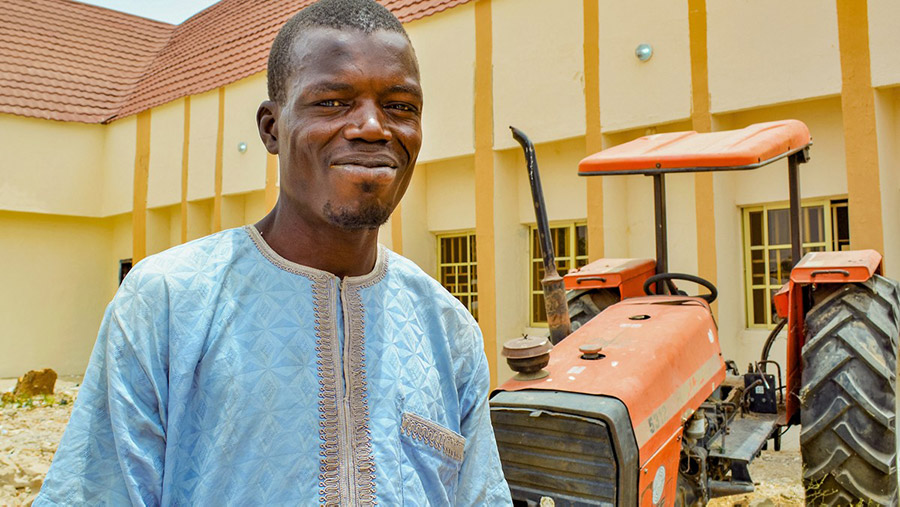Using a green jobs assessment model developed by ILO, UNDP’s NDC Support Programme has been supporting Zimbabwe and Nigeria to quantify how climate and green economy policies would affect job creation. Photo: UNDP Nigeria/Bridget Jangfa
As countries develop revised national climate pledges, known as Nationally Determined Contributions, they’re doing so in the context of multiple historic crises: climate change, rising inequality, and the health and economic impacts of COVID-19. Fortunately, it’s possible to address all three at once, through a just transition to a green economy. UNDP and ILO are supporting governments to make an evidence-based shift, with benefits for people and the climate.
Remember where you were at the turn of the 2020 – who could have known what was to come? What started as a cluster of cases of pneumonia, rapidly unfolded into a global public health emergency and then full-scale socio-economic crises.
As well as the many lives lost, more than 500 million jobs were put in jeopardy by the COVID-19 pandemic, with at least 100 million permanently lost. These numbers reflect not just an economic crisis, but a humanitarian one. Behind every job lost is a person. Many of them women, young people and already vulnerable informal economy workers, often supporting entire families.
The case for a green economy
It has been an immensely challenging year for governments who have been scrambling to contain the spread of the virus while also managing the economic fallout, supporting workers, and ensuring continuity of schooling for children. At the same time, the climate crisis has not gone away, nor has the soaring gap between rich and poor. In fact, these existing challenges have been magnified by the pandemic.
Despite the gloom, there’s some good news; with the right choices, governments can address all of these crises at once, by making the transition to low-carbon, green economies.
Creating jobs
The International Labour Organization (ILO) estimates that the move to low-carbon, greener economies has the potential to create 60 million jobs by 2030.
But what are the tradeoffs? To inform the decision-making of governments and businesses, they need the evidence. We must use hard data to show how climate action, and shifting to a green economy, will have overwhelming benefits, and not just for the environment, but also in generating more jobs.
To do this, we need to measure, and assess, the environmental, social, and economic implications of climate policies and investments. This includes looking at the data, but also asking the questions – will everyone benefit equally? What would construction of, say, a hydropower plant or solar farm mean? Would it create jobs for skilled urban workers or benefit women working in informal economies? Are the skills, labour and technology to build and run such projects domestically available? What would a transition to 100 percent renewable energy look like for workers?
By identifying the synergies and trade-offs between climate action and broader development needs, policymakers can enhance the positive impacts of recovery packages and lead systemic changes.
Using a green jobs assessment model developed by ILO, UNDP’s NDC Support Programme has been supporting Zimbabwe and Nigeria to quantify how climate and green economy policies would affect job creation, including for women and youth, income distribution, skills development and economic growth in their context.
The process has yielded some interesting and instructive results, with the modelling revealing very different medium- and long-term job growth implications.
In Zimbabwe, of the dozen climate investments and policy scenarios modelled – covering energy, industrial processes, agriculture and forestry – investments in conservation agriculture created up to 30,000 jobs for every million US dollars invested. This number stands in high contrast to only 100 jobs created for each million invested in a hydro dam and 25 in commercial solar.
Nigeria found similar positives for green policies. Some 25,000 jobs stand to be created through public transport initiatives, and 12 million through a massive increase in renewable energy. Agriculture and forest-related policies were found to have the highest value for money, with water efficiency initiatives seeming to create more jobs for women in the long run.
These findings provide insights for policymakers in Zimbabwe and Nigeria, as well as in other countries, to understand the distributional impact of policies, and ultimately to choose those which reduce greenhouse emissions and bring considerable economic and social benefits.
The results of the modelling, together with policy recommendations on leveraging job opportunities and achieving just transition of the workforce, will be reflected in the countries’ NDCs and further realized through ILO and UNDP’s country programmes.
If you don’t measure it, you can’t manage it
When it comes to climate policy-making and related investments, we need to have a multi-dimensional approach, aimed not just at cutting greenhouse gas emissions, but raising GDP, creating jobs, and ensuring a just and equitable transition for all.
We can help policymakers find the best path by providing the evidence.
Some jobs will be lost as we transition away from fossil fuels. But many more jobs will be created, and they have the potential to employ those who have been previously left behind.
It is only when you assess the socio-economic implications of a green transition, that you can maximize the opportunities.
Let’s seize this moment for transformation.
To learn more about UNDP and ILO’s ongoing support to governments to measure the socio-economic impacts of climate policies and use modelling to guide evidence-based policymaking, please contact Sangji Lee at sangji.lee@undp.org | Tw: @Sangji_climate
UNDP’s NDC Support Programme is funded by the European Union and the governments of Germany and Spain as a contribution to the NDC Partnership.

 Locations
Locations
